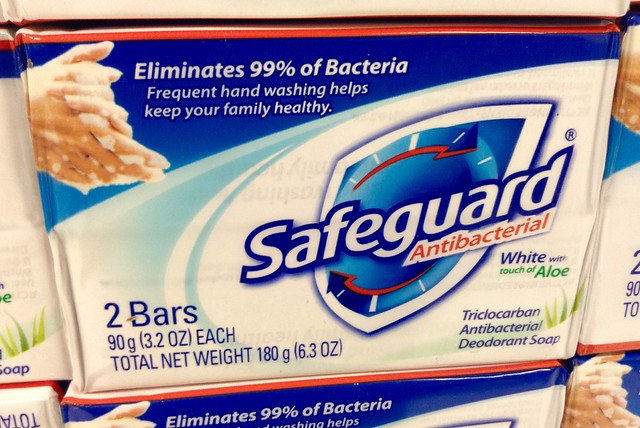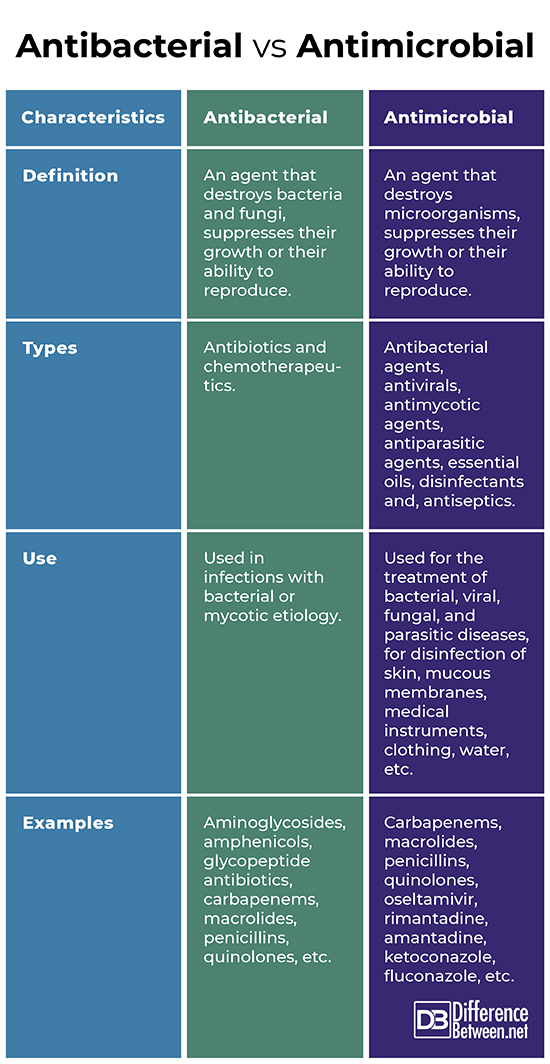Difference Between Antibacterial and Antimicrobial
The main agents used for the treatment or prevention of infectious diseases of different etiology are the antibacterials and antimicrobials. They are a large group of action-specific preparations that are subdivided according to the pathogenic agents against which they are effective.
Antibacterials destroy and prevent the development of bacteria and fungi, while the antimicrobials are effective against bacteria, fungi, parasites, and some viruses. In fact, the antibacterials are a type of antimicrobials.

What is Antibacterial?
Antibacterial is an agent that destroys bacteria and fungi, suppresses their growth or their ability to reproduce. Antibacterial agents include antibiotics and chemotherapeutics.
Antibiotics are a large group of antibacterial preparations, produced by bacteria or fungi. They are widely used in clinical practice and are prescribed in different infections with bacterial or mycotic etiology.
The first known natural antibiotic is the penicillin, found by Alexander Fleming in 1928. It is isolated from the fungus Penicillium rubens and is widely used for the treatment of syphilis, Lyme disease, streptococcal, pneumococcal, and meningococcal infections, etc. Examples of antibiotics are aminoglycosides, amphenicols, glycopeptide antibiotics, carbapenems, macrolides, penicillins, quinolones, etc.
Chemotherapeutics are synthetically produced antibacterial agents.
Bacteria are capable to develop resistance to certain medications by various mechanisms, the most common being mutations of certain genes that increase their resistance. As a result of widespread and injudicious use of antibacterials, there is an increasing emergence of antibiotic-resistant pathogens. This results in a serious threat to global public health.
Different antibacterial preparations have different mechanisms of action. For example, the group of penicillins binds to specific structures in the bacteria, thus activating enzymes in their walls, leading to self-destruction. Tetracyclines, suppressing some stages of protein synthesis in microorganisms, lead to the cessation of their propagation. Polymyksins destroy the permeability of the bacterial membrane. They act destructively primarily on gram-negative bacteria.

What is Antimicrobial?
Antimicrobial is an agent that destroys microorganisms, suppresses their growth or their ability to reproduce.
Antimicrobial agents are used to treat or prevent infectious diseases of different etiology. They are a large group of preparations, subdivided according to the type of action and the pathogenic agents against which they are effective.
Depending on their properties, the antimicrobial agents are divided into two main groups. The first group consists of preparations that kill the microbes (bactericides, virucides, fungicides). The second group consists of preparations, suppressing their growth and multiplication (bacteriostatics, viruostatics, fungostatics).
Some antimicrobial agents are administered once (e.g. in helminthosis), others require intake for a relatively long time (e.g. in bacterial infections) or for a lifetime (antiretroviral drugs used in AIDS).
The major groups of antimicrobials include antibacterial agents, antivirals, antimycotic agents, antiparasitic agents, essential oils, disinfectants, and antiseptics.
Antibacterial agents include antibiotics produced by bacteria or fungi and chemotherapeutics, which are synthetically produced.
Anti-viral drugs are characterized by a narrow spectrum of action. There is little difference between the maximum therapeutic and minimal toxic doses, so they have to be applied with caution. The main groups of antivirals target several major viral families – retroviruses, hepatitis and herpes viruses, and influenza viruses. They are prescribed to infected persons, contact patients, or healthy hosts. Their main purpose is to kill the viruses or suppress their multiplication. Examples for such preparations are oseltamivir, rimantadine, and amantadine, used against the influenza virus.
Human and fungal cells are both eukaryotic, which makes it difficult to synthesize a preparation that is active against the fungi and safe for the cells of the host. Preparations used in the treatment of mycotic infections (antimycotic agents) are antibiotics and chemotherapeutics that damage pathogenic fungi by various mechanisms. They affect the permeability of the cell membrane, inhibit cell division, inhibit cell wall synthesis or essential nucleic acids synthesis. The most commonly used antimycotic agents belong to the group of azoles (ketoconazole, fluconazole), allylamines (terbinafine) and polyene antibiotics (amphotericin B, nystatin).
Antiparasitic agents are used in infections caused by different worm species (nematodes, trematodes, cestodes) or protozoan species (malaria, trichomoniasis, toxoplasmosis).
A number of essential oils have an antimicrobial effect, including cinnamon, clove, and thyme oil that are rich in terpenoid substances and secondary metabolites.
Antiseptics and disinfectants destroy all microorganisms and are mainly used for disinfection of skin, mucous membranes, medical instruments, clothing, water, etc.
Ozone also has antimicrobial activity. It is mainly used to purify water and air. In medicine, so-called ozone therapy is used in inflammatory, neoplastic, autoimmune, and infectious diseases.
Physical methods with an antimicrobial effect are the use of radiation and dry heat sterilization.
Difference Between Antibacterial and Antimicrobial
Definition
Antibacterial: Antibacterial is an agent that destroys bacteria and fungi, suppresses their growth or their ability to reproduce.
Antimicrobial: Antimicrobial is an agent that destroys microorganisms, suppresses their growth or their ability to reproduce.
Types
Antibacterial: Antibacterial agents include antibiotics and chemotherapeutics.
Antimicrobial: Antimicrobial agents include antibacterial agents, antivirals, antimycotic agents, antiparasitic agents, some essential oils, disinfectants, and antiseptics.
Use
Antibacterial: Antibacterial agents are widely used in clinical practice and are prescribed in many infections with bacterial or mycotic etiology.
Antimicrobial: Antimicrobial agents are used for the treatment of bacterial, viral, fungal, and parasitic diseases, for disinfection of skin, mucous membranes, medical instruments, clothing, water, etc.
Examples
Antibacterial: Examples of antibacterial agents are aminoglycosides, amphenicols, glycopeptide antibiotics, carbapenems, macrolides, penicillins, quinolones, etc.
Antimicrobial: Examples of antimicrobial agents are carbapenems, macrolides, penicillins, quinolones, oseltamivir, rimantadine, amantadine, ketoconazole, fluconazole, etc.
Antibacterial vs. Antimicrobial

Summary of Antibacterial vs. Antimicrobial:
- Antibacterial is an agent that destroys bacteria and fungi, suppresses their growth or their ability to reproduce.
- Antimicrobial is an agent that destroys microorganisms, suppresses their growth or their ability to reproduce.
- Antibacterial agents include antibiotics and chemotherapeutics. Antimicrobial agents include antibacterial agents, antivirals, antimycotic agents, antiparasitic agents, essential oils, disinfectants, and antiseptics.
- Antibacterial agents are widely used in clinical practice and are prescribed in many infections with bacterial or mycotic etiology. Antimicrobial agents are used for the treatment of bacterial, viral, fungal and parasitic diseases, for disinfection of skin, mucous membranes, medical instruments, clothing, water, etc.
- Examples of antibacterial agents are aminoglycosides, amphenicols, glycopeptide antibiotics, carbapenems, macrolides, penicillins, quinolones, etc. Examples of antimicrobial agents are penicillins, quinolones, oseltamivir, rimantadine, amantadine, ketoconazole, fluconazole, etc.
- Difference Between Gallstones and Cholecystitis - September 5, 2021
- Difference Between Constipation and Cramping - August 4, 2021
- Difference Between Whole Genome Sequencing and Microarray - May 6, 2021
Search DifferenceBetween.net :
Leave a Response
References :
[0]Aarestrup, M. Antimicrobial Resistance in Bacteria of Animal Origin. Bel Air: ASM Press. 2006. Print.
[1]Bryskier, A. Antimicrobial Agents: Antibacterials and Antifungals. Bel Air: ASM Press. 2005. Print.
[2]Sköld, O. Antibiotics and Antibiotic Resistance. Hoboken: John Wiley & Sons. 2011. Print.
[3]Image credit: https://commons.wikimedia.org/wiki/File:AntiMicrobial_Symbol.png
[4]Image credit: https://www.flickr.com/photos/jeepersmedia/16197470700
